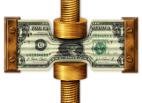 Summary: In most cases, tax cuts cause an increase in generated tax revenue. This is because people have more money to spend in the economy, and as the money changes hands it gives more people the opportunity to engage in activities that can be taxed. A concrete, simplified example is given of how this occurs.
Summary: In most cases, tax cuts cause an increase in generated tax revenue. This is because people have more money to spend in the economy, and as the money changes hands it gives more people the opportunity to engage in activities that can be taxed. A concrete, simplified example is given of how this occurs.Tax cuts are nearly always effective, in that a tax cut results in an increase in revenue to the taxing entity. In some instances tax cuts may not be effective, but those instances are few. To give an example of one of these few instances—if the current tax rate is 1 percent, and the amount of money to be taxed is 1 billion dollars, and if the tax is reduced to 0 percent, the difference is 10 million dollars of lost revenue.
Tax cuts, however, are nearly never from 1% down to 0%. There is in every instance a ‘break-even point’ at which reducing taxes brings in less revenue. Currently, however, most taxing schemes are far above such a break-even point. In other words, most tax rates would benefit from being cut.
When a tax is remitted to the government, it goes to pay off a government activity. When a part of that tax is left to the taxpayer in the form of a rate reduction, the money that the taxpayer keeps is much more likely to change hands many more times in the economy.
Let’s say, for example, that I make $50,000 per year. Under an old tax rate of 10% my taxes would have been $5,000. But a new tax rate of 8% would require me to pay only $4,000. Because I save $1,000, it at first appears that the government will be losing money on the deal. What is important, however, is what I now can do with that money, and the ripple effect that will have, which it cannot have when I pay that money in taxes. For example, let’s say I choose to buy a new computer with my extra money. If several money-saving taxpayers make the same choice, the computer store will be able to hire a new employee. The new employee now has more disposable income to go out and maybe buy a new motorcycle, an MP3 player, or maybe even invest some of his income in a certificate of deposit at the local credit union. This gives the computer store, the motorcycle shop, the electronics store, and the credit union more revenue, meaning they can now pay the government more in taxes. If the example is continued, it becomes clear that, because of how many more times more money will be able to change hands in the economy, more tax revenue will be generated as a result.
In a nutshell, let’s take a simplified example. Let’s assume in our sample economy that the amount of money to be taxed is $1,000,000,000, and that the old and new tax rates are 10% and 8% respectively. At the old 10% tax rate, $100,000,000 is sent to the government and $900,000,000 is left to circulate in the economy. At the new 8% rate, $80,000,000 goes to the government and $920,000,000 stays in the economy. If the $20,000,000 extra money now in the economy changes hands 100 times in the next year, being taxed at 8%, it will generate $160,000,000 of additional revenue ($20,000,000 * .08 * 100), giving the government $140,000,000 more in revenue by the end of the year.
This is all nice theory, right? Well, on a recent episode of the Michael Medved Show, Mr. Medved cited government revenue statistics before and after tax cuts during the Reagan, George H.W. Bush, and George W. Bush administrations. In every case, revenues increased significantly after the tax cuts.
Why these administrations (and congresses) ran deficits does not take away the fact that the tax cuts brought in more revenue. Republicans and Democrats are equally to blame for yearly US budget deficits, but this is not a problem of tax revenue, but rather a problem of overspending—much like a family getting a $3,000-per-year raise suddenly thinking it has $10,000 more in disposable income.
The discussion on how elimination of pet projects from the Federal Budget could balance the budget will be the subject of a future post.
Comments
Post a Comment
Thank you for commenting. If you have a Google/Blogger account, to be apprised of ongoing comment activity on this article, please click the "Subscribe" link below.